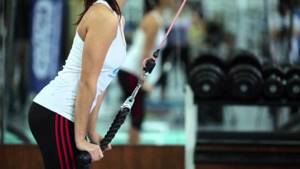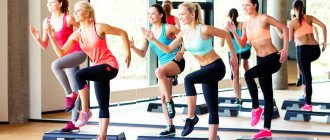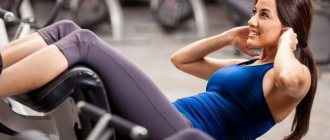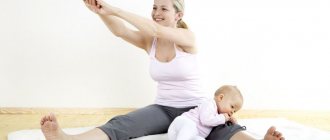11.25.2017 Category: Recovery after childbirth Author: Alena Lomakina
Weight gain during pregnancy is a natural process, and even with proper nutrition and exercise, the needle on the scale will move upward. When the baby is born, some of the kilograms will go away, but often mothers, upon returning home, discover that they cannot fit into their old things. The issue of restoring your figure comes to the fore, and here it is important to follow a number of rules in order not only to get a good result, but also not to harm yourself or your child.
- Rules for training
- Simple exercises after childbirth for all muscle groups
Ab exercises
- Hoop exercises
- Exercises for the chest and back
- Fitball exercises
- Working out the legs - “bicycle”
- Exercises for hemorrhoids
- Cindy Crawford Complex “New Dimension”
Video: “New Dimension” by Cindy Crawford, Complex A
When can a nursing mother exercise after giving birth?
It’s worth starting by adhering to the main rule - do not harm the body.
It’s clear that during nine months of gestation everyone gains weight: some to a greater extent, some to a lesser extent.
This depends on the usual sports activity before pregnancy, during it, and, of course, on who ate how much and whether they ate for two.
After the birth of a child, an increase of up to five kilograms is considered adequate - the rest is lost due to the weight of the child himself and amniotic fluid. The size of the mammary glands also increases, and swelling appears.
All this results in sad numbers on the scales.
Some problems go away on their own, while others remain on the woman’s conscience. Therefore, at the first stage of returning to its former form, it is important to determine your departure from the norm.
To do this, we calculate the body mass index (BMI): divide your weight by the square of your height. For example, 60/(1.60x1.60)=23.4.
With a BMI less than 19, an increase of up to 15 kilos is considered acceptable (during pregnancy, of course); at 19-26 - up to 12; with a score of 26 and above, you should not have scored more than 9.
From this simple mathematics it becomes clear: if you gain weight, the fat layers will not dissolve on their own. It's time to hit the gym.
The birth of a child changes not only the figure, but also the character of a woman
First preparation
Your body has had nine months of rest from physical activity, so don't immediately grab barbells and dumbbells. You need to start exercising gradually, increasing the load over time. If you can’t leave your child with a nanny or grandma to go to the gym, it doesn’t matter. You can do fitness after childbirth at home; fortunately, there are many video courses for this. In addition, daily walks with your baby are also considered a kind of exercise. Walking burns calories. So don’t sit on a bench, but walk, walk and walk again.
There are exercises that you can do immediately upon returning from the hospital. After them, it will be much easier for you to start more intense training. So, these include:
- Kegel exercise. It is necessary to restore the elasticity of the pelvic muscles.
- Breathing exercises
- Exercises with fitball. You can practice with this equipment every day. For example, while breastfeeding, you can sit on a stability ball and perform circular movements with your pelvis.

Where should a nursing mother start?
This is a question we must answer in the second stage.
Immediately after the birth of your baby, create a proper balanced diet, taking into account the advice of your obstetrician-gynecologist and pediatrician: if you are breastfeeding, diet and exercise should not harm either you or the baby.
Some girls start training within a month after giving birth; others, especially if there was a difficult pregnancy and cesarean section, have to postpone the start of classes for another two or three.
The recovery period depends on chronic diseases, blood pressure, normal physical fitness (it’s foolish to think that if you weren’t particularly active before pregnancy, your muscles will quickly recover), and the tendency to bleed.
Start training with minimal loads
If you feel great, you can start when the postpartum discharge stops.
In the case of a cesarean section, you will have to avoid abdominal exercises, various crunches and planks for at least two more months.
It is also worth remembering that during childbirth there is a slight deformation of the pelvic bones, spine and back muscles.
This means that classes should be light and measured, so Pilates, proper breathing practices, some yoga asanas, and gymnastics for the back, arms and legs would be an ideal option for getting back in shape.
Many girls are interested in the question: when can they start exercising after giving birth with stitches?
The answer is clear - only after their removal and complete postoperative recovery.
There is absolutely no need to provoke discrepancy, bleeding and possible prolapse of the uterus.
And in the case of a cesarean section, for example, you can start training the abdominal muscles approximately six months after the operation.
Give up an active sports lifestyle for a while in favor of proper nutrition and walks in the fresh air.
If you decide to exercise with dumbbells, their weight should not exceed a kilogram
General recommendations
An important part of any fitness plan is nutrition. Everything you knew about calorie counting can be forgotten for now. The main thing is to focus on simple, healthy foods. It is better to cook vegetables by steaming or grilling. You should pay special attention to the choice of sports supplements and vitamins, especially if you continue to breastfeed your baby. By the way, the daily protein intake for pregnant and lactating women is almost 50% higher than usual. You can also discuss this with your doctor. After childbirth, the body needs more iron, calcium, and vitamin D.
It’s worth preparing for home workouts not only psychologically. It will be much more convenient to take all the equipment from a specially designated place or even set up a small home gym. Otherwise, excuses may arise such as: “a child is sleeping in the room, I can’t make noise”, “children are playing in the room”, “the dumbbells are left in the garage, and the weather is bad outside, so I will skip training today.”
After completing the program and regularly performing physical exercises after giving birth, you will not only be able to return to your previous shape, but also make it even more attractive. The developed training plan helped Jamie herself and millions of women around the world once again become the owner of a beautiful, fit figure and learn to find time for sports in their new life with a child.
How to combine fitness and breastfeeding?
When you know that you can already exercise after giving birth, it is especially important to follow simple rules when breastfeeding so that exercise does not harm the baby’s health:
- Your exercise schedule should coincide with feeding. Ideally, you should start after your first morning feed, but before your breakfast. This is necessary so that the body produces less lactic acid, which gives milk an unpleasant taste.
- You should refrain from too intense workouts, even if you are in good health - exercise on exercise machines, with dumbbells and weights can lead to a decrease in milk supply.
- Half an hour of training at the first stage will be enough, do not drive yourself to a nervous breakdown with photos of fitness girls on the Internet and the miraculous quick return to their former form of podium divas.
- You need to exercise in a special sports bra to securely hold your enlarged breasts and in a bandage if you had a caesarean section.
- Drink water during exercise and restore the balance of lost fluids.
- After sports, eat protein foods and reduce the amount of carbohydrates you consume. Eat more approved hypoallergenic vegetables and fruits.
Use a special bandage to support your stomach
How to combine raising a baby with physical activity
Many mothers complain that the child takes up too much time and sometimes there is no strength or desire left to exercise. In this case, you can easily combine exercises with caring for your baby.
Read also:
How to regain your figure after a caesarean section
Walks. Give up the stroller and, in the warmer months, place your child in a slim or kangaroo carrier and go hiking! Walking burns a lot of calories, and the added challenge of having a baby will help tone your abdominal, leg, and buttock muscles, as well as strengthen your back muscles.
Games. Play more outdoor games with your baby. With a child in your arms, you can squat, turn your body and bend over. In this case, the child will have fun, and such games will bring you a lot of benefits.
When can you exercise after childbirth with ruptures?
The recovery and healing process is individual for everyone, but if stitches were placed after childbirth, only a doctor can guide you, so it is especially important not to miss a routine examination by a gynecologist.
It may take up to six months for the body to fully strengthen and return to shape, otherwise there is a danger of the stitches coming apart.
With your doctor's permission, practice Kegel exercises
The only exception in this case may be Kegel exercises - they strengthen the muscles of the perineum and vagina, help overcome the problem of urinary incontinence and normalize blood circulation in the pelvis.
In a normal birth, they can be performed the very next day.
For ruptures, careful training begins 1-1.5 months after suturing, sometimes earlier.
It is important to monitor your well-being and the absence of discomfort.
And we repeat again - every woman’s body is individual, do not be shy and do not be lazy to ask the doctor if it is possible.
The first physical activity, when it is already possible for a nursing mother to engage in gentle sports after childbirth, is recommended by the famous doctor Evgeniy Komarovsky to start with the most basic:
- Walk and walk with children more often
- Standing more than sitting means you'll burn twice as many calories.
- Find a friend to go shopping and play sports together, while talking you will not noticeably increase the distances traveled
- Praise yourself for regularity and fidelity to training
- Take them seriously and don’t look for excuses from the series: “I’m a mother, I have a child, I don’t have time,” because 99.99% of success is your desire and desire to return your body to its former attractiveness
Take more walks in the fresh air
Exercises for Beginners
If conditions permit and a woman is focused on quick results, she should not skip a set of preparatory exercises for beginners. Excessive load will negatively affect health; during lactation, the production and quality of milk decreases. The following postpartum training program is designed for beginners and can be done at home with a baby.
Exercises:
- legs back;
- bench press with a child;
- lunges;
- twisting;
- with a hoop.
Legs back. Kneel down, lean forward on your palms. Straightening your leg, pull it back parallel to the floor and return it to its original position. 20 reps on each side. The exercise trains the gluteal muscles. The butt is tightened, the shape is rounded.
Bench press with a child. Take the newborn in your hands, place it on your forearms, hold it with your palms. Extend your arms forward. Feet shoulder width apart. Pull the baby to the chest, pressing the shoulder part to the torso. Repeat 30 times. This exercise will bring your pectoral muscles and triceps back into shape. The arms will take on smooth contours and the chest will rise slightly.
Lunges with a child. Take the baby in your arms, as in the previous exercise, with your feet together. Lunge forward, one at a time on each leg (20 times). Effective for the whole body.
Twisting. Lie on your back, hands behind your head, legs bent at the knees. Raising your torso without lifting your back off the floor, it is important to feel the tension in your abs. 30 times in one approach. To make it more difficult, you can place the baby on your stomach. The main emphasis is on the upper press.
Hoop. Stand up, spread your legs slightly, toes forward. Sit down so that you can feel the thigh muscle. Start spinning the hoop and continue for 20-30 minutes. If your legs get tired, take a standing position, but do not stop rotating the hoop. This activity reduces your waist size to 5 cm in 30 days. When squatting, the internal and external muscles of the thighs are trained.
Postpartum training from the complex for beginners is performed daily for 1-2 months. Then, proceed to more difficult exercises.
Where to put the “pregnant” belly after childbirth?
If you did not stop working out in the gym before and during pregnancy, the muscles will begin to return to normal in the first two weeks after birth and will support the uterus, preventing it from protruding.
In other cases, you have to fight with your stomach.
In women who have not taken care of their body, such a protrusion can last more than two months, and after that it is impossible to do without training to cope with sagging skin and stretch marks.
After giving birth, when should a nursing mother go in for sports and start doing those same non-press exercises?
If the birth was natural and easy
Abdominal muscle training can begin when vaginal discharge completely stops.
It usually takes up to 8 weeks for full recovery. Do not rush into the training process immediately, increase activity and time gradually.
Don’t jump straight into complex abdominal exercises to avoid getting the opposite effect.
During caesarean section
You can start pumping up your abs in six months, when the uterine scar is fully mature.
With diastasis
Under no circumstances should you perform exercises aimed at training the rectus abdominis muscle.
Mild diastasis will go away quite quickly, but your doctor will be able to tell you the degree of discrepancy and how to deal with it. Do not self-medicate and do not complicate your life.
Why are muscles needed and where do they disappear?
Our musculoskeletal system consists of bones, ligaments and muscles. Joints are formed where bones meet. Muscles hold bones in the required position relative to each other and allow us to move. That is, the first function is maintaining posture and moving . Muscles also support internal organs. Often, the internal organs themselves consist of muscle tissue, for example the heart, uterus, intestines, etc. That is, the third function of muscles is structural .
Muscle tissue is very active metabolically. At rest, she consumes a lot of energy, about 13 kcal per hour per 1 kilogram of weight. By the way, adipose tissue consumes 2 times less energy. Thus, if the number of muscles in the body increases, then the metabolism will speed up, and quite significantly - up to 50%. For a real person, this means that you can finally eat pasta with meat and not gain weight.
Where can our muscles disappear?
- Age . Every year the percentage of muscle tissue in the body inexorably falls.
- Hormonal changes . Stress hormones promote active breakdown of muscle tissue. “Pregnant” hormones work on the same principle (have you noticed that many mothers’ butts disappear somewhere?).
- Hunger . Nothing destroys our muscles like a low-calorie diet. With each session of some kind of diet with two sprigs of parsley, tea and an egg in the daily diet, the muscles become smaller and smaller.
- Inaction . As we have already said, muscle tissue is quite gluttonous. So why keep such a glutton who does nothing?
But what should we do? How to stop this process of catabolism (breakdown, breakdown) of muscle tissue?
Let's look at the list above. We cannot control the first point. The second - indirectly, for example, by changing your attitude towards stressful situations. The third and fourth are completely in our control. And, what’s most amazing! A balanced diet plus active muscle work can not only stop, but also reverse the processes of catabolism!
With nutrition, everything is clear, today everyone knows that all nutrients are needed for health: proteins, fats, and carbohydrates, and in a certain ratio. But we haven’t figured out physical activity yet. It would seem that there is nothing more active than cardio - hail sweat, fatigue and brutal hunger after a workout aren’t these the best indicators of good work? But no. Cyclic activities (running, exercise bike, elliptical, jumping, etc.) do not load the muscles. They put stress on the cardiovascular and respiratory systems. The muscles are used very sparingly.
Strength exercises involve many times more muscle fibers. That's why they're so hard to do. Moreover! Strength exercises, especially with weights, lead to the fact that energy is wasted not only during the activity, but also for a day or more after physical activity.
Types of gymnastics
In the absence of contraindications, a woman can safely begin searching for the most suitable gymnastics for her. The choice can be very diverse and depend on the individual characteristics of the body.

The most common and popular complexes include:
- maintaining breast shape – helps eliminate stretch marks, restore beauty and firmness without harming the breastfeeding process;
- tightening the abdominal area is an excellent option for the abs in order to restore elasticity and fit;
- eliminating extra pounds;
- strengthening the vaginal muscles - help to avoid the occurrence of various pathological processes and restore sexual activity;
- for the spine – help eliminate pain and excess stress;
- respiratory processes - to supply the optimal amount of oxygen to the brain and other internal organs.












